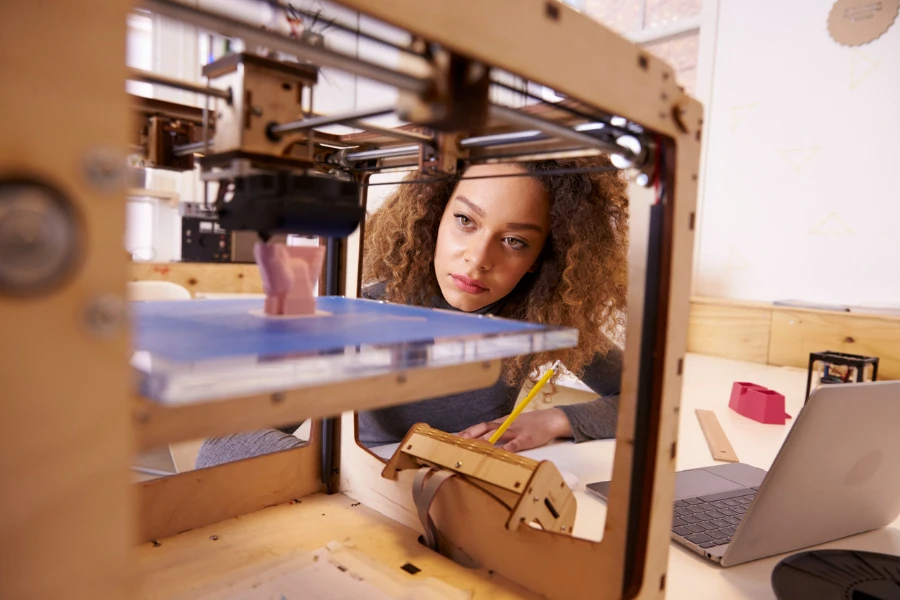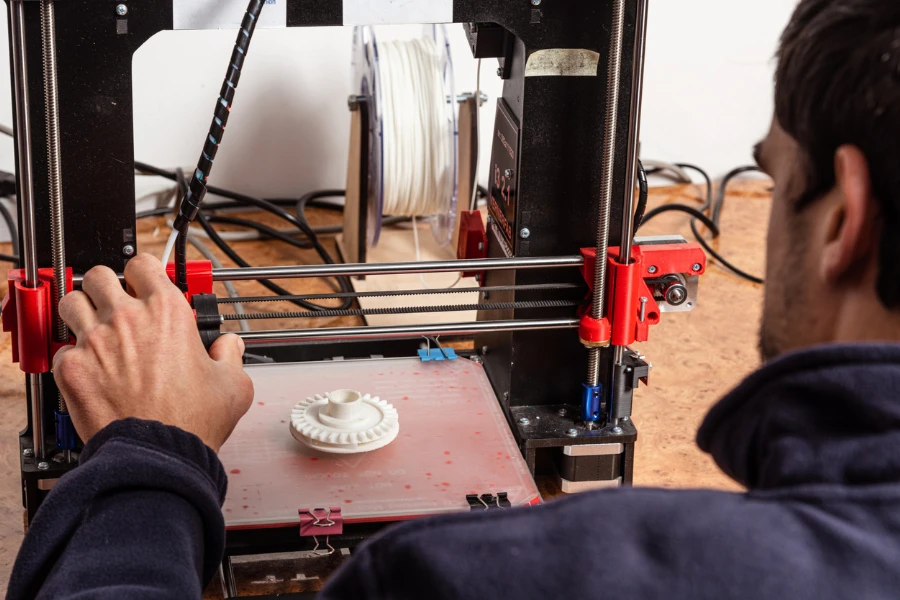From rapid prototyping to personalized manufacturing, 3D printers have found applications across diverse sectors, making them a valuable addition to many tech businesses’ product lineups. Looking for the best 3D printers on the market in 2024? You’ve come to the right place. Here, we outline the best 3D printers to add to your product lineup this year.
Not quite sure if selling 3D printers is the right fit for your business but still want to get in on the action of this growing market? Check out our guide on selling 3D printers to determine if they’re a good fit for your business.
Table of Contents
Understanding the 3D printing market
Understanding your target audience
Choosing the best 3D printers
The 6 best 3D printers for your business
Final thoughts
Understanding the 3D printing market
Before diving into our top picks, let’s take a brief look at the state of the 3D printing market. According to Grandview Research, the global 3D printing market was valued at over US$ 20 billion in 2023 and is projected to grow at a compound growth rate (CAGR) of 23.5% between 2024 and 2030. In 2023, North America emerged as the dominant force, commanding over 33% of the global revenue, signaling a robust foothold in this transformative technology.
Understanding your target audience

Before determining which 3D printers to purchase, it’s crucial to define your target audience. Understanding the needs, preferences, and expectations of your customers will guide your selection process and ensure that you offer printers tailored to their requirements.
If you’re adding 3D printers to an existing product lineup, consider the demographics of the customers who are already visiting your store and the types of 3D printers that would appeal to them the most.
Here are some categories that your target audience may fit into:
- Hobbyists and DIY enthusiasts: This segment comprises individuals passionate about crafting and creating. They seek affordable yet versatile 3D printers that allow them to bring their ideas to life.
- Educators and students: Schools, colleges, and universities increasingly integrate 3D printing into their curriculum. Printers suitable for educational settings should be user-friendly, reliable, and capable of producing high-quality prints.
- Small businesses and startups: For entrepreneurs and small businesses, cost-effectiveness, reliability, and scalability are paramount. They require printers that can meet their prototyping and production needs without breaking the bank.
- Professional designers and engineers: Professionals in industries such as engineering, architecture, and product design demand precision and performance from their 3D printers. They prioritize accuracy, speed, and advanced features for intricate projects.
- Tech enthusiasts: Tech-savvy individuals who are intrigued by cutting-edge technology and innovation. They will likely be early adopters and seek 3D printers with advanced features and capabilities to satisfy their curiosity and creative endeavors.
Choosing the best 3D printers

Once you have identified your target audience, it’s time to evaluate the factors differentiating 3D printers and determine which models align with your business objectives.
Here are the key considerations:
- Printing technology: 3D printers utilize different printing technologies, each with advantages and limitations. Fused Deposition Modeling (FDM) and Stereolithography (SLA) are the most common types. FDM printers are more affordable and suitable for beginners, whereas SLA printers offer higher resolution and are ideal for detailed prints.
- Build volume: The build volume refers to the maximum size of objects that a printer can produce. Consider the projects your customers will likely undertake and choose printers with adequate build volumes to accommodate their needs.
- Print quality and resolution: The resolution determines the level of detail and smoothness of prints. Higher-resolution printers are essential for applications that require precision and fine surface finishes.
- Material compatibility: Different 3D printers support various printing materials, including PLA, ABS, PETG, and specialized filaments like flexible or composite materials. Ensure that the printers you choose are compatible with the materials your customers intend to use.
- Ease of use and maintenance: User-friendly interfaces, intuitive software, and hassle-free maintenance are critical factors, especially for beginners and educational institutions. Look for printers with robust customer support and readily available spare parts.
- Speed and efficiency: While print speed may not be a priority for all users, businesses with high-volume production requirements benefit from faster printers that minimize turnaround times and maximize efficiency.
- Connectivity and compatibility: Consider the connectivity options the printers offer, such as USB, Wi-Fi, or Ethernet, and ensure compatibility with popular operating systems and design software.
The 6 best 3D printers for your business
With many options, selecting the best 3D printers for your business can be challenging. To simplify the process, we’ve curated a list of top picks across different price points and use cases:
#1 – Bambu Lab P1P – Best overall
Bambu Lab is a premium 3D printer designed for professionals and small businesses seeking unparalleled precision and quality in their prints. This printer boasts high-precision printing capabilities, making it ideal for intricate prototyping and small-scale production projects.
Specifications
- Printing technology: FFF/FDM
- Build area: 256 x 256 x 256mm / 10.08 x 10.08 x 10.08in
- Layer resolution: 80 microns to 280 microns
- Weight: 9.65kg / 21.28lb
- Dimensions: 386 x 389 x 458mm / 15.20 x 15.31 x 18.03in
With its advanced features, such as auto-bed leveling, filament runout detection, and a robust metal frame, Bambu Lab ensures reliable performance and consistent results. Its large build volume provides ample space for complex designs with exceptional detail and surface finish.
The Bambu Lab P1P even boasts printing right from the box. However, it is still in pre-order at the beginning of 2024. That being said, Bambu Lab has many other brilliant 3D printers, including:
- Bambu Lab A1 – Budget-friendly option with fast swappable nozzles and multicolor potential
- Bambu Lab A1 Mini – Smaller, budget-friendly option for beginners
- Bambu Lab P1S – The predecessor to the P1P, a fast, fully enclosed 3D printer with multi-material possibilities
- Bambu Lab X1 Carbon – Premium 3D printing with next-gen intelligence
#2 – Mingda Magician X2 – Best on a budget
The Mingda Magician stands out as a versatile 3D printer capable of handling complex printing tasks with ease and on a budget.
Specifications
- Printing technology: PEI Spring Steel, heated
- Build area: 230 x 230 x 260 mm / 10.2 x 9 x 9 in
- Layer resolution: 0.1 mm to 0.4 mm
- Weight: 7.4kg / 16.3lb
- Dimensions: 460 x 430 x 546 mm / 18.1 x 16.9 x 21.4 in
Its spacious build platform allows for creating architectural models, sculptures, and functional prototypes in sizes that were previously challenging to achieve. It has many beginner-friendly features, such as 16-point auto leveling, a quick swap extruder, and a removable PEI build platform.
However, there are some sacrifices with a budget printer, and with this one, it’s the print speed—the recommended print speed for the Mindga Magician is 60 mm/s, whereas the Bambu Lab machine can reach speeds of 500 mm/s or higher.
#3 – Creality Ender-5 S1 – Best for small businesses
The Creality Ender series has established itself as a staple in desktop 3D printing, offering affordability, versatility, and reliability in one package. The Creality Ender lineup, including models such as the Ender 3 V2, Ender 5, and Ender 6, caters to diverse users, from hobbyists and educators to small businesses and startups. These printers feature robust construction, large build volumes, and user-friendly interfaces, making them ideal for beginners and experienced users.
The Creality Ender-5 S1 has an overhauled control board from the original Ender-5 and hotend, which has improved the overall print quality and speed of prints, making it great for small business use and product designers.
Specifications
- Printing technology: Fused Deposition Modeling (FDM)
- Build area: 220 x 220 x 280mm / 8.66 x 8.66 x 11in
- Layer resolution: 50 microns to 350 microns
- Weight: 12.1kg / 26.68lbs
- Dimensions: 425 x 460 x 570mm / 16.73 x 18.11 x 22.44in
#4 – Elegoo Neptune 4 Pro – Best for beginners
The Elegoo Neptune is a versatile and user-friendly 3D printer suitable for a wide range of applications, from hobbyist projects to educational use and small-scale production. With its sturdy construction and intuitive interface, the Neptune offers reliable performance and ease of use, making it an excellent choice for beginners and experienced users alike.
Specifications
- Printing technology: Fused Deposition Modeling (FDM)
- Build area: 225 x 225 x 265mm
- Layer resolution: 0.05mm to 0.3mm
- Weight: 8.9kg
- Dimensions: 475 x 445 x 515mm
The Elegoo Neptune 4 Pro is equipped with a heated print bed, filament runout sensor, and silent stepper motor drivers. This printer ensures consistent and high-quality prints with minimal noise and hassle.
Its compact design and relatively affordable price point make it accessible to individuals and businesses looking to explore the world of 3D printing. While it isn’t the cheapest option, it offers an excellent overall value proposition.
#5 – Snapmaker J1 – Best for precision
While Snapmaker is known for 3-in-1 machines, the J1 is a dedicated 3D printer that does not transform into a CNC or laser engraver. Although this machine isn’t 3-in-1 like some of its siblings, it stands out for its precision as a 3D printer.
Specifications
- Printing technology: Fused Deposition Modeling (FDM)
- Build area: 250 x 220 x 220mm / 9.84 x 8.66 x 8.66 inches
- Layer resolution: 50 microns to 300 microns
- Weight: 25kg / 55.12lb
- Dimensions: 490 x 445 x 443mm / 19.29 x 17.52 x 17.44 inches
The Snapmaker J1 has an IDEX design, making it a dual-material machine with nearly independent hotends for faster printing. The biggest downsides of this machine are that it’s more expensive than other dual-head printers and quite heavy. Despite its cost, the J1 is a standout for precise prints and ease of use.
#6 – AnyCubic Kobra Plus – Best large scale
The AnyCubic Kobra Plus immediately stands out for its large-scale printing capabilities, but it’s so much more than that. This 3D printer is remarkably reliable and easy to use.
Specifications
- Printing technology: Fused Deposition Modeling (FDM)
- Build area: 300 x 300 x 350mm / 13.8 x 11.8 x 11.8 in
- Layer resolution: 50 microns to 300 microns
- Weight: 11kg / 24.25 lbs
- Dimensions: 605 x 560 x 546 mm / 23.8 x 22.0 x 21.5 in
While the size may seem daunting, its intuitive design and lightweight construction make it easier to set up and operate than it appears. It seamlessly integrates many features like auto bed leveling and filament detection.
Final thoughts
Integrating 3D printers into your tech business can unlock opportunities, from catering to hobbyists and educators to serving professionals and small businesses. By understanding your target audience and considering factors such as printing technology, build volume, print quality, and ease of use, you can select the best printers to meet your customers’ needs.
Whether you’re looking for affordable entry-level options or high-end printers for professional applications, the market offers diverse choices to suit every budget and requirement. Embrace the future of manufacturing with 3D printing and position your business for success.




